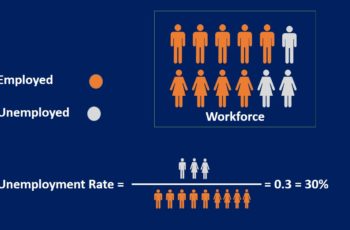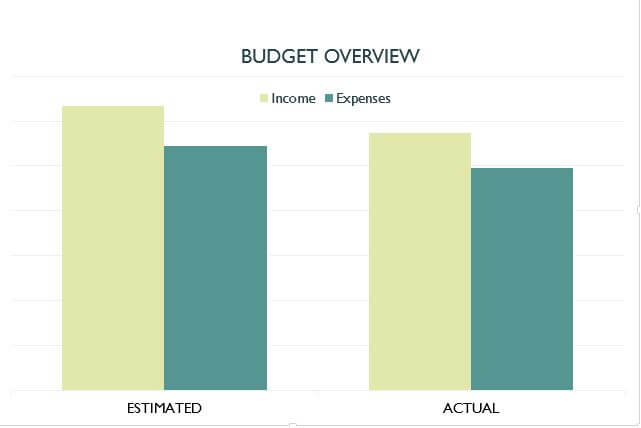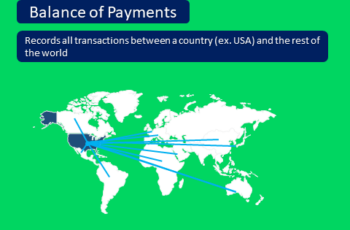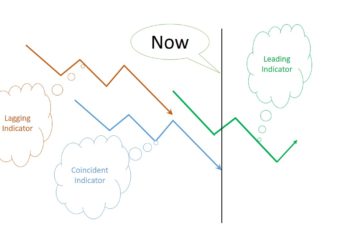GDP stands for Gross Domestic Product. And gross domestic product is the total monetary value of all products produced and services provided in a given period in a specified geographic area.
In GDP calculation, we sum up all monetary value of products and services.
Products are real assets, such as computers, clothes, and cars. Services are doing jobs that do not create a product but create value, such as teaching, doctor visits, etc.
The unit value in the gross domestic product is a currency, not bitcoin, gold, silver, or something else.
Institutions calculate the gross domestic product for a specified period, usually monthly, quarterly, or annually. The time is specified and does not count GDP for a randomly selected period.
Authorities measure GDP in a specified geographic boundary. The boundaries are such as a state, province, country, region, continent, and the whole world.
Gross domestic product measures the gross monetary value and does not count depreciation value. Depreciation is the lost value of an asset during a specified time, usually one year. If we deduct the depreciation from the GDP, we get the Net Domestic Product (NDP).
There are three ways to calculate the GDP. And they are product, income, and spending approaches.
Types of GDP
To analyze the health of the economy and the true value created in a country, economists divide it into Nominal, Real, and Potential gross domestic products.
1. Nominal GDP
Nominal gross domestic product is measured based on the current monetary value of what we hear daily about the prices of products and services.
In nominal gross domestic product, we do not consider price appreciations and depreciations. Appreciation means gaining value and depreciation is losing value.
Nominal GDP growth is calculated just by summing all of the monetary value of final goods and services in a period and specific place and deducting it from last year’s nominal gross domestic product.
2. Real GDP
Real GDP is inflation-adjusted which measures the actual value of products and services in the economy.
Prices rise due to the money supply increase, and the real gross domestic product deducts these price rises.
Real GDP growth only happens if there is production growth. It does not count the current price of products and services.
The real gross domestic product is measured based on a year. For example, based on ten years ago, in 2012, the GDP of 2022 will be calculated. Next year (2023), the Real GDP is also calculated based on 2012 to get a realistic picture of gross domestic product.
3. Purchasing Power Parity (GDP)
Purchasing Power Parity (PPP) states the ability of one unit of money (commonly USD) in different nations.
A higher national GDP PPP indicates a bigger economy and vice versa. Moreover, it means that the citizens of that country enjoy a higher living standard.
The International Comparison Program (ICP) of the World Bank Produces the PPPs globally with the help of several institutions worldwide. Some of these institutions are IMF, OECD and Eurostat.
The PPP is a better for measuring the living standards in various countries as it truly represents costs of education, health, food, etc.
4. GDP Per Capita
GDP per Capita PPP shows the power of the International Dollar to purchase a basket of goods and services in a country. It is a metric to compare Purchasing Power Parity of individuals in different countries.
Higher the number shows how rich truly a country is.
To calculate GDP Per Capita PPP, you need to consider a basket of goods and services. A single item can not represent the overall price differences among various nations. For example,
a laptop computer costs almost the same all over the world. You may find a tiny difference caused by different tariff rates, but the price does not differ too much.
To find how the calculation takes place, visit the official page of World Bank discussing the method.
5. Potential GDP
The Potential GDP refers to an ideal economic situation, such as when the unemployment rate is low, the currency is stable, and the inflation is low.
How to Find GDP Data?
Being aware of the current economic situation of countries for investors is crucial, and it is the most widely used indicator in the world to gauge the strength and trend of economies.
Generally, there are two ways to get the GDP number; from official organizations and secondary publishers.
1. Economic Calendar
For online traders, the economic calendar is the best choice. It releases on time, has a short description, and provides historical value in one place.
Moreover, it is easy to use.
The economic calendar illustrates that the GDP has a high impact. More in the following screenshot.
It provides a short description.
And provides you the historical values.
2. Official Websites
Every country has an official organization that surveys and releases the GDP.
Here is the list of official entities that release the gross domestic products in the top 5 economies.
- The USA: U.S. Bureau of Economic Analysis
- China: National Bureau of Statistics of China
- Euro Area: Eurosat, a subsidiary of the European Commission Office
- Japan: Cabinet Office, an entity of the Government of Japan
- UK: Office for National Statistics
3. Third Party Publishers
Unofficial Publishers gather data from all over the world, cluster it, and provide you with a table, chart, or histogram.
These organizations make your job easier. They not only release the data but also predict based on models that they have developed.
Statista and Trading Economics are my two favorite sources. For investors, it is helpful to see these data after a while.
Furthermore, World Bank and IMF also publish the GDP and economic forecasts. However, they are late, and stock market traders, do not add value.
Interpreting GDP
A gross domestic product number only demonstrates the size of an economy.
However, to analyze the health and potential of an economy, investors look for the gross domestic product trend and its components.
1. Gross Domestic Product Trend
The trend predicts where the economy of a country is heading.
In a country where the gross domestic product is growing steadily and has not experienced a major downtrend, the chance is very high to continue to grow. In a country where the gross domestic product growth rate is not stable, the chance of being unstable is very likely.
For example, China’s GDP growth rate has continued to be positive since 1970, and it is a sign that it will continue to be positive in the upcoming years. And Canada’s gross domestic product is very dependent on oil. If the oil price rise, Canada’s GDP will rise as well, and so on. That is why the gross domestic product of Canada in 2012 was larger than today.
2. Components of GDP
Components of the GDP of a country predict its future performance.
In a country where manufacturing is a big portion of its Gross Domestic Product (GDP), it says that the country is a developing country.
What they manufacture is also important. In a country that produces only a few goods, its economy can trend upward or downward very quickly. Its economy is very dependent on its customer. If the customer finds another seller cheaper, the chance of falling increases.
In a country where service is a larger part of its gross domestic product, it is very likely to be a developed nation.
For instance, the USA is a developed country, And its service industries are worth more than 60% of its GDP.
Top 10 Economies by GDP
The top 10 economies in 2021 by gross domestic product in the world are the USA, China, Japan, Germany, the UK, India, France, Italy, Canada, and South Korea.
GDP vs GNP
Gross domestic product measures the economic output in a country irrespective of who lives there. In other words, gross domestic product measures all economic activities by citizens and foreigners in a geographic boundary.
On the other hand, gross national income measures the economic activities of citizens of a country everywhere in the world.






